Tallinn
![]()
The title of this article is ambiguous. For other meanings, see Tallinn (disambiguation).
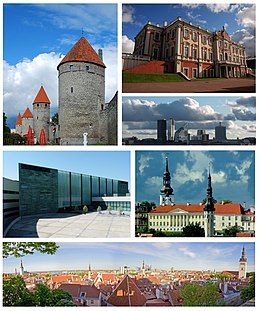
Tallinn (German pronunciation [ˈtalɪn], Estonian pronunciation [ˈtɑlʲˑinˑ]) is the capital as well as the economic and cultural centre of Estonia and, with about 430,000 inhabitants, also by far the largest city in the country. It is located on the Gulf of Finland of the Baltic Sea, about 80 kilometers south of Helsinki.
Until 24 February 1918, Tallinn was officially called Reval [ˈʀeːval], a name still in use in German-speaking countries afterwards. In Low German, the name is Revel. Other older names are Russian Ревель (Rewel) and formerly Колывань (Kolywan), Danish Lyndanisse, Swedish Lindanäs or Reuel.
The name Tallinn was given to the city in Estonian from the time of its conquest by the Danish King Waldemar in 1219, and is usually derived from Taani-linn(a), meaning "Danish city" or "Danish castle" (Castrum Danorum in Latin).
Geography
Climate
Tallinn is characterized by a cold climate. The highest precipitation is recorded for August.
| Tallinn | ||||||||||||||||||||||||||||||||||||||||||||||||
| Climate diagram | ||||||||||||||||||||||||||||||||||||||||||||||||
| ||||||||||||||||||||||||||||||||||||||||||||||||
| Monthly average temperatures and precipitation for Tallinn
Source: wetterkontor.de | ||||||||||||||||||||||||||||||||||||||||||||||||||||||||||||||||||||||||||||||||||||||||||||||||||||||||||||||||||||||||||||||||||||||||||||||||||||||||||||||||||||||||||||||||||||||||||||||||||||||||||||||||||||||||||||||||||||||||||||||||||||||||||||||||||||||||||||||||||||||||||
City breakdown
Tallinn is divided into the districts of Haabersti, Kesklinn, Kristiine, Lasnamäe, Mustamäe, Nõmme, Pirita and Põhja-Tallinn and 84 districts.
- Haabersti: Astangu, Haabersti, Kakumäe, Mäeküla, Mustjõe, Õismäe, Pikaliiva, Rocca al Mare, Tiskre, Väike-Õismäe, Veskimetsa, Vismeistri
- Kesklinn: Aegna, Juhkentali, Kadriorg, Kassisaba, Keldrimäe, Kitseküla, Kompassi, Luite, Maakri, Mõigu, Raua, Sadama, Sibulaküla, Südalinn, Tatari, Tõnismäe, Torupilli, Ülemistejärve, Uus Maailm, Vanalinn, Veerenni
- Kristiine: Järve, Lilleküla, Tondi
- Lasnamäe: Katleri, Kurepõllu, Kuristiku, Laagna, Loopealse, Mustakivi, Pae, Paevälja, Priisle, Seli, Sikupilli, Sõjamäe, Tondiraba, Ülemiste, Uuslinn, Väo
- Mustamäe: Kadaka, Mustamäe, Sääse, Siili
- Nõmme: Hiiu, Kivimäe, Laagri, Liiva, Männiku, Nõmme, Pääsküla, Rahumäe, Raudalu, Vana-Mustamäe
- Pirita: Iru, Kloostrimetsa, Kose, Laiaküla, Lepiku, Maarjamäe, Mähe, Merivälja, Pirita
- Põhja-Tallinn: Kalamaja, Karjamaa, Kelmiküla, Kopli, Merimetsa, Paljassaare, Pelgulinn, Pelguranna, Sitsi
Neighborhood
Tallinn is bordered by Viimsi to the northeast, Jõelähtme to the east, Rae to the southeast, Saku to the south, Vasalemma to the southwest and Harku to the west.
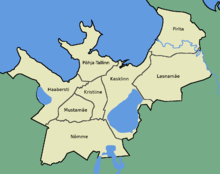
Districts of Tallinn
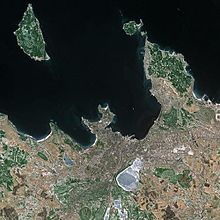
Tallinn from space
History
The origins of Reval date back to a wooden castle (on today's Cathedral Hill) and a presumed Estonian trading post built in the mid-11th century. At the same time, Tallinn's port was established during this period. The name Reval derives from the Estonian name of the historical county of which the city was the centre, and was first coined for the castle and later city by Danes and Germans (Estonian also Rävälä, according to Henry of Latvia Revele, according to the Waldemar Earth Book Revælæ).
Danish rule
In 1219, the Danish King Waldemar II conquered the old Estonian castle (Battle of Lyndanisse) on Cathedral Hill, rebuilt it and began building a cathedral church for the bishop of the Estonians, suffragan of the Archbishop of Lund, appointed by Denmark around 1167 in the course of his missionary work. However, Denmark could not hold the castle for long against the rebellious Estonians and the advancing Germans. In 1227, the Order of the Brothers of the Sword conquered Reval with papal permission and received the castle and much of present-day Estonia for administration from the hands of the papal governor in Estonia.
Probably in order to strengthen its position against the rural vassals, the Order of the Brothers of the Sword recruited 200 Westphalian and Lower Saxon merchants from Gotland in 1230, who settled below the castle and were granted freedom of customs and land. Although a foundation charter has not been handed down, this is probably the actual foundation of the city of Reval.
When the Order refused to hand back its feudal dominions and the castle to the papal legate three years later, the Danish king reasserted his claims to Reval and Estonia. After the crushing defeat at the Battle of Schaulen in 1236, the Order of the Brothers of the Sword sought union with the Teutonic Order, which the Pope approved only in exchange for the surrender of Reval. Thus, in 1237, the Order of the Brothers of the Sword passed into the Teutonic Order as the Livonian Order, and Reval fell to Denmark in 1238. In this context, Reval was mentioned for the first time as civitas (citizenship, city).
Under renewed Danish rule until 1346, the town rapidly grew in size and economic importance. In 1248, the Danish king granted it the Lübische Stadtrecht, which was valid until 1865. However, this did not apply to the Domberg. The first councillors were appointed with the same document. The city gradually received extensive privileges that made it largely independent of the sovereign. The official language in Tallinn was German until 1889.
Although Reval was under (increasingly loose) Danish rule, the city retained a German upper class, and since this consisted almost exclusively of merchants, close contact was maintained with the Hanseatic League. The fact that Reval considered itself to belong to the Hanseatic League can be documented as early as 1252 and is explicitly mentioned in 1285 at the latest. Of economic importance was the Danish decision of 1294 to allow all German merchants the trade route to Novgorod via Reval and Narva. This allowed Reval to become a hub of Hanseatic Baltic trade.
Reval and the Teutonic Order
After the suppression of a great Estonian uprising with the help of the Teutonic Order, the Danish king released his Estonian vassals from their oath of allegiance in 1346 and sold his rights to Northern Estonia to the Teutonic Order. Reval, which had had all existing and some new privileges confirmed by the Danish king the year before the sale, was now granted all privileges by the new sovereign and was thus able to further expand its legal and autonomous position during the change.
Reval, part of the "Livonian Third" of the Hanseatic League, together with Riga and Pernau received the right of staple in 1346, which obliged all merchants trading with Russia to call at one of the three cities and offer their goods on the market for a period of three to eight days. Several exclusive trading rights for the Revaler merchants ended the free trade in the city, which had been open to everyone until then. The hitherto most important trading town in the Baltic, Wisby, could not recover to its previous supremacy from the sacking by the Danish king in 1361 and in the war years that followed, and when at the turn of the century the Vitalien brothers were banished from the Baltic, Reval was the most important town of the Hanseatic Eastern trade.
However, trade with Russia did not always remain unclouded. After several uncertain years, trade with Novgorod broke off completely in 1471 due to attacks by the Muscovites, and in 1478 the hitherto independent principality was finally conquered by the Muscovites. The Grand Duchy of Moscow waged war against Livonia, with which it now shared a common border. The invasion of Livonia by the Muscovite Russians in 1481 brought a severe outbreak of plague to the city, which was overcrowded with refugees. Other severe years of plague in the city were 1464, 1495/96 and 1519/20. After a short period of peace, during which the Novgorod trading post was reopened and closed again, a successful war campaign of the Teutonic Order against Moscow followed in 1501-1503, which was followed by a peace lasting until 1558.
The wars with the Moscow Russians brought heavy losses in economy and population for Livonia and Reval. It was not until 1514 that the Livonian cities of Reval and Dorpat re-established a trade relationship with Novgorod, which led to a newer economic flourishing until the 1550s. In the 16th century the city had about 6000-7000 inhabitants.
The Reformation reached Reval in 1523/24, and its final breakthrough came in July 1524, when representatives of the Livonian towns and knights gathered in Reval's town hall and decided to stick to the Protestant doctrine and defend it by all means. In September 1524 there was an iconoclasm in which the furnishings of three churches fell victim. The losses were relatively small, since the council was able to restore public order the very next day and arranged for the restitution of the stolen art treasures. All in all, it can be said that the Reformation in Livonia and in Reval took place without bloodshed. On September 9, 1525, the new doctrine became "official" in Reval with the enactment of a Lutheran church order by the council and the guilds.
Protective power Sweden and Russian rule
The remainder of the Order's rule was marked by internal and external strife until Moscow's invasion of Livonia in 1558-1561 defeated the Teutonic Order. Reval turned to Sweden as a protecting power, beginning a period of Swedish rule in the city that lasted until the Great Northern War of 1710.
In 1549 the Olai church received a Gothic tower, which was rebuilt after fires in 1629 and 1820 respectively. Today it is 123.7 meters high.
In 1561, the city became Swedish during the Livonian War. The Swedes gradually reduced the prerogatives of the Germans, but not to the extent that the Estonians initially hoped with regard to the status of the peasants in Sweden.
- 1631: Foundation of the first grammar school
- 1684: devastating fire on the cathedral hill
- 1710: Plague epidemic, Reval had 2000 inhabitants afterwards
As a result of the Great Northern War, Reval fell to Russia in the course of the Siege of Reval in 1710. Peter I fully restored the old German councillors to their original positions, then over the next two centuries the rights of the city government were gradually reduced.
Republic of Estonia 1918-1940
On February 24, 1918, the independent Republic of Estonia was proclaimed; the city, now called Tallinn, eventually became the capital of independent Estonia. Actual independence was won in the War of Independence (1918-1920) and crowned by the peace treaty with Soviet Russia.
Soviet Republic and the Second World War
A secret additional protocol to the German-Soviet non-aggression pact (in August 1939) cleared the way for the conquest of Estonia by the Soviet Union. The German Baltic population was resettled from the port of Tallinn to the newly created Reichsgau Wartheland on Hitler's orders. After the Soviet occupation in June 1940, the Estonian Soviet Socialist Republic was proclaimed, whose capital remained Tallinn. The first deportations of the Estonian population - especially the political and cultural elite - to Siberia and northern Russia began. In the Soviet waves of terror after 1940 and then again from 1944/45, a total of one in fifteen Estonians was murdered and one in seventeen deported to Siberia for at least ten years.
In 1941, the German Wehrmacht occupied Tallinn, sending the city and country from one despotism to another. Hitler pursued the goal of annexing Estonia to the German Reich. The restoration of independence hoped for by the Estonians did not take place. Nevertheless, many young Estonians participated in the advance of the German Wehrmacht to the east and took part in extermination actions. The German occupation forces had the Jewish population of Tallinn and Estonia almost entirely murdered.
On 9 March 1944, a heavy Soviet air raid took place. Eleven percent of the Old Town was destroyed and 600 people were killed. During the war, the character of the Old Town was preserved despite bombardments by the Soviet Air Force against German troops stationed in and around Tallinn. The Wehrmacht was driven back from Tallinn and Estonia by the Soviet Army in the Baltic Operation by the end of 1944, and Soviet rule was restored. Prisoner of war camp 286 for German prisoners of war of World War II existed in the city.
Republic of Estonia as of 1991
After 51 years, Tallinn once again became the capital of an independent Estonia on August 20, 1991, at the time of the Moscow coup. As a result of the immense economic growth and the greatly increased prosperity in some classes, huge new housing estates were built around Tallinn within a few years. For example, in the Peetri area south of Tallinn, single-family and multi-family houses were built on a former moor. Especially young families, who have profited from the economic development in recent years, are settling here. The result is a stark contrast to the large socialist-style housing estates. The prices for apartments in the new housing estates are partly already on a western level.
At the end of April 2007, riots and looting, mainly by young people of Russian origin, led to the most serious unrest in Tallinn since the collapse of the Soviet Union. The reason for this was the relocation of the Bronze Soldier of Tallinn from its original location in the city centre to a military cemetery on 27 April 2007, which was arranged by Estonian authorities after a lengthy prior announcement. Estonians associate this monument with the Soviet occupation period rather than the liberation from German occupation in World War II, to which the monument is dedicated (and which it symbolizes for Russians and the Russian minority in Estonia). As a result of the monument controversy, there was a serious crisis in relations between Estonia and Russia, which vehemently opposed the implementation of the statue.

The Linnahall - a legacy from the Soviet era

The new skyline of Tallinn. Dominating are the twin towers of the Swissôtel Tallinn

Tallinn 1941

Map of Reval from 1810

Reval around 1900

Revalia (Reval) around 1650 (copper engraving by Adam Olearius)

View from 1630
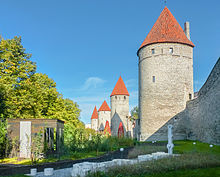
Part of the medieval city wall
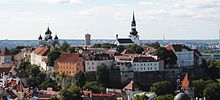
View of the Domberg
Search within the encyclopedia